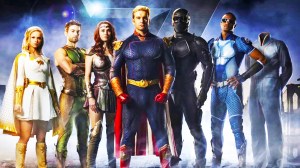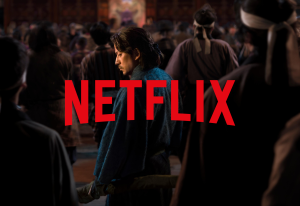An important day has come for all of you fans of Alita: Battle Angel. After a powerful debut earlier this year, the live-action anime is ready to land itself in a movie collection near you. The Blu-ray and DVD release of Alita: Battle Angel has gone live, and ComicBook.com has got a special surprise in store for fans.
Videos by ComicBook.com
Recently, we were able to speak with Nick Epstein who acted as a VFX Supervisor on the live-action venture. The creator, who has worked on projects like Avatar and Furious 7, was ready to talk all things manga and anime when it came to Alita: Battle Angel. So if you want to find out how Yukito Kishiro’s beloved franchise was brought to the big screen, then you can find out all the nitty-gritty secrets behind Alita: Battle Angel below:
—
First, I wanted to ask you, what was the most important thing that you and the visual effects team wanted to bring over from the anime, if anything at all?
Nick Epstein: Obviously for us, I think our main job is really honoring the vision of the filmmaker. Some of that is obviously decided on the filmmaker level. You know [James Cameron] had been developing this property for a long time; I think you probably know the history.
But you know, you have this 600 page bible. Robert [Rodriguez] has his version of the shooting script. We had really, really solid direction, and I guess in terms of their vision, I think one of the cool things that we were able to bring to this was really based off of the direction from them. It is all about capturing the heart of the manga, and you’ll see it in some of the marketing materials for a scene like Underworld. We actually [had] animators working with cells from the manga to make sure that we were hitting as many of the sort of really iconic poses, key beats from that Underworld fight directly from the manga.
We know that there’s differences between Grewishka and Makaku in the original manga. Grewishka’s much more similar to the anime. But we were still bringing up Kishiro’s original artwork, and saying, ‘All right, where can we hit that exact beat when Alita raises her legs to that exact pose. Right, that’s going to work at the apex of this jump,’ for example.
I think we did that really quite successfully. There were a few other sequences where we went through those exercises. But I think the filmmakers too, when they were filming it, even the live-action, they were referring back to the manga. The scene where Alita wakes up and discovers her hands, for example. There’s a lot of beats and poses, for example, that are directly from the manga. That’s sort of the opening pages of the manga. And I think you really notice that. Maybe it’s things that only the fans are going to notice, but I think it’s is really cool that the filmmakers wanted to get that stuff right.
As part of the visual effects team, I wanted to ask what was your greatest challenge in trying to adapt those static manga pages into something that had movement, into something that you know was 3D and physical and something that would move in front of fans?
Epstein: I think that probably overall one of the hardest things we had to deal with was the slightly stylized nature of Alita. We obviously had Rosa’s beautiful performance to go off. But Alita really is just sort of like a manga-fied version of Rosa and it’s just not something that your brain naturally accepts as being realistic. So you know that is the challenge. Like how do you ground some of this? There’s a stylized look, and also the stylized nature of the action. I think a lot of that came down to getting reference on it where we could. I mean if you’ve seen some of Rosa’s training videos, she really got into that character. She went there in a lot of the fight scenes and so on.
We also had stunt performances, so we obviously tried to get as close to sort of the stylized action, exaggerated actions as we can. But obviously scenes like Motorball, Underworld and so on where we really do draw on our creative expertise we’ve developed over the years, to realize those moments.
You know, that just just came down to iterations really. And working with the animation team. As I said, some of the animation supervisors were really, really big fans of the manga, like I am. It was actually a really pleasant experience for us to get into that level of detail and really be able to explore that and iterate on those actions with Robert.
What was it like kind of creating how Motorball would look aesthetically?
Epstein: I guess I should preface this by saying that Motorball was done by a different team, it wasn’t my team. We split the work into chunks at Weta. So that was not one of my sequences.
I think what I guess I probably can say, was that the process of Motorball, we developed the previz in house for that scene. I think we did have a lot of creative input with the filmmakers. You know, we’re a vendor, so we would pitch stuff over to the filmmakers. They would give us direction. But the way that the previz came about, was we would do vignettes of action. You don’t just design shots in isolation, you know that between this point and this point we go from here to here and Alita takes out three Motorballers.
Right? Then you would create the vignette of action without being tied to camera moves. You cover that the same way that you would cover a piece of live-action. We run the same action over and over again, you get your camera covered and you sort of like pitch different versions of that over to Robert, and then that forms the basis for discussions. The other thing is that, Robert was pretty clear about some of these Motorball scenes.
We would get previz, we would get storyboards from him, which would actually include cells from the original manga. Now that was pretty cool to see as a fan. He was actually integrating the original cells and then he would do his drawings in between. But it was a sort of collaborative effort like figuring out how Motorball would work really end up. It’s probably also worth pointing out that Framestore did the final comp for Motorball, we did everything that was on the track.
I wanted to ask, you being now familiar with how the stylization and visual effects and anime can work in live-action and Hollywood, what do you think is one of the most important things that Hollywood can do in order to get that stylization right for future live-action anime films?
Epstein: I mean I think a lot of it comes from collaboration with the original authors as well. So I think that Jim and Robert both engaged with Kishiro through the process of developing it. And I think that that probably shows, and that’s why I think this is deemed as a successful live-action manga adaptation.
I think also really getting into virtual production type workflows, some of this stuff doesn’t necessarily have a basis in reality. So the more you can iterate on this stuff in a sort of virtual space, the quicker you will come to sort of a collective, subjective way forward. That’s one of the things we did here with scenes like Underworld and Motorball and so on.
We did use virtual production techniques so that Robert and Bill, for example, could cover the action with their own vertical cameras. “Hey, this is how I want the action framed.” But I think it’s gonna come down to collaboration between those two worlds, shall we say. And I think that shows in the final product of Alita.
—
So, are you ready to rewatch Alita: Battle Angel? Let me know in the comments or hit me up on Twitter @MeganPetersCB to talk all things comics and anime!
Battle Angel Alita (known as GUNNM in Japan) was originally created by Yukito Kishiro for Shueisha’s Weekly Business Jump in 1990. The series is set in a post-apocalyptic future and follows Alita, a cyborg who is found in a garbage heap by a doctor and rebuilt. Completely devoid of her memory, all she has to cling to is a legendary cyborg martial art known as Panzer Kunst. With this knowledge, Alita decides to become a bounty hunter. The series has since been licensed for an English language release by Viz Media, and collected into nine volumes.








